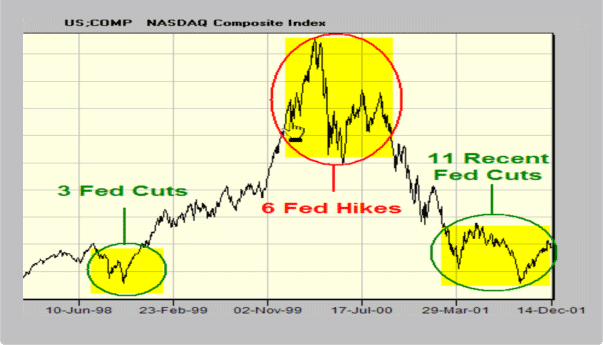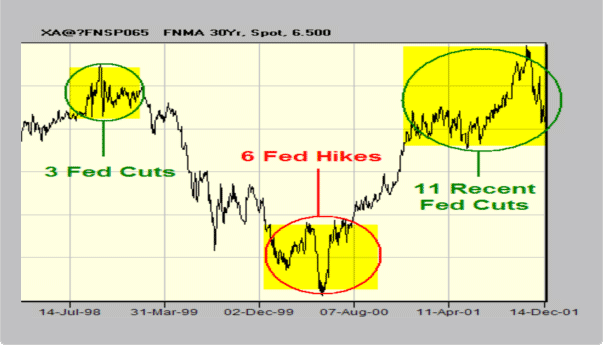So the Federal Reserve cut rates again. Many mortgage applicants are calling their mortgage representative and expecting a lower interest rate. Others who have been waiting to refinance are puzzled as to why mortgage rates have not moved lower during recent 5 Fed rate cuts. In fact mortgage rates are now higher than they were before the Fed began cutting rates by in January. This is difficult to explain to many consumers who have watched a 2.5% reduction by the Fed with no benefit in mortgage rates. Is a Fed rate cut really good news for mortgage rates? The facts may be surprising. The Fed can only control the Discount Rate and the Fed Funds Rate. This is very different from mortgage rates. A mortgage rate can be in effect for 30-years, a rate that is set by the Fed can change from one day to another. Another common mistake is in thinking that 30-year Treasury bonds or 10-year Treasury notes are directly pegged to mortgage rates. Those are government securities that are backed by the full faith and credit of the U.S. government and have no direct effect on mortgage rates. So what are mortgage rates based on? As it turns out the answer is mortgage-backed bonds known as Mortgage Backed Securities (MBS). Bonds issued by Fannie Mae and Freddie Mac (MBS) and the trading performance of those bonds will determine the direction of mortgage rates. Finding the catalyst that causes mortgage bonds to move will give you the keys to finding out what makes mortgage rates rise or fall. We know that inflation will always be a negative for any long-term bond because it eats away at the future returns. Since the bond will pay a set amount over a long period of time, that amount will be less valuable if inflation is high. Over the past several years, one catalyst that seems to be working in the opposite direction of MBS prices is the Nasdaq and broader stock market. As bond prices rise, interest rates fall. As bond prices fall, interest rates rise. The charts accompanying this article show the Nasdaq Composite Index and the Fannie Mae 6.5% mortgage bond tend to follow paths that are almost mirror images of each other. The consistency of this behavior is astounding. As the Nasdaq moves higher, bond prices move lower causing interest rates to rise. As the Nasdaq declines, mortgage bonds benefit, causing mortgage rates to fall. Additionally, and unlike common opinion, Fed rate cuts have had virtually no direct effect on mortgage rates. Moreover, it appears that since Fed rate cuts act to stimulate the Nasdaq, they have a negative effect on mortgage rates. |
||
|
The bottom line is that it appears mortgage rates will get better if the Nasdaq sells off and will get worse if the Nasdaq rallies. So it is not necessarily what the Fed does that affects mortgage rates, it’s how the Nasdaq and broader stock market interprets the Fed’s action that will ultimately influence the direction of mortgage rates. This is because money managers and mutual fund companies typically keep funds in either stocks or bonds with very little in cash. If stocks are in favor, money is pulled from bonds, causing bond prices to drop and interest rates to rise. When stocks are being sold off, the money is then parked into bonds, which improves bond prices and causes interest rates to decline. On the chart of the Nasdaq Composite Index above, notice how the price movement higher on the Nasdaq seems to correlate to mortgage bond price deterioration (shown below) and vice versa. Once again, lower bond prices translate to higher mortgage rates and higher mortgage bond prices mean lower mortgage rates. The chart below shows how the Fannie Mae 6.5% mortgage bond has performed during the same time period. The green circles indicate Fed rate cuts and the area circled in red shows when the Fed hiked rates.
A closer look at the 5 rate cuts by the Fed this year (see chart below) shows that mortgage bond prices deteriorated after each Fed rate cut. This means that mortgage rates rose after the Fed had cut rates while many consumers were expecting their mortgage rates to decline. Worse yet are the consumers who missed the opportunity to obtain a lower rate because they mistakenly waited for the anticipated Fed action to cut short-term rates, thinking that longer-term mortgage rates would decline as a result.
Predicting the future is tough, so nothing is written in stone. Keep an eye on the Nasdaq, and keep in mind that the best rates may be behind us. But, mortgage rates are still low and could have some quick dips so make the most of them while they last. |



